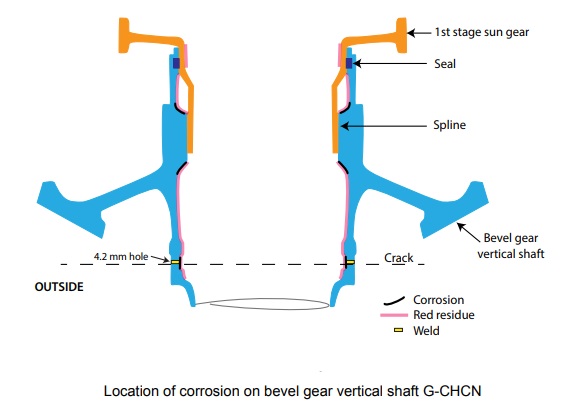AAIB Report on the Ditchings of EC225 G-REDW 10 May 2012 & G-CHCN 22 Oct 2012
The UK Air Accidents Investigation Branch (AAIB) have published their combined report into the two Eurocopter EC225 helicopter ditchings in the North Sea in 2012:
….the crews of G-REDW and G-CHCN experienced a loss of main rotor gearbox oil pressure, which required them to activate the emergency lubrication system. This system uses a mixture of glycol and water to provide 30 minutes of alternative cooling and lubrication. Both helicopters should have been able to fly to the nearest airport; however, shortly after the system had activated, a warning illuminated indicating that the emergency lubrication system had failed. This required the crews to ditch their helicopters immediately in the North Sea. Both ditchings were successful and the crew and passengers evacuated into the helicopter’s liferafts before being rescued. There were no serious injuries.
The loss of oil pressure on both helicopters was caused by a failure of the bevel gear vertical shaft in the main rotor gearbox, which drives the oil pumps. The shafts had failed as result of a circumferential fatigue crack in the area where the two parts of the shaft are welded together.
The emergency lubrication system operated in both cases, but the system warning light illuminated as a result of an incompatibility between the helicopter wiring and the pressure switches. This meant the warning light would always illuminate after the crew activated the emergency lubrication system.

G-REDW (Credit: Michael Coull)
Ten safety recommendations have been made by AAIB. In addition, the helicopter manufacturer and other organisations have initiated a number of safety actions as a result of this investigation.

G-CHCN
Oil & Gas UK commented:
We are aware that the parties to which the relevant recommendations have been directed have been actively involved in the compilation of this report, and have been taking action. We welcome it, and the progress that has already been made towards addressing these recommendations, such as the redesign, approval and introduction of a replacement vertical shaft.
Airbus Helicopters has been very open and engaged with industry and workforce representatives throughout the whole investigation into the underlying causes of these incidents, and this high level of engagement has been hugely welcomed.
While the physical causes of the shaft crack and the EMLUBE switch failure have been briefed and debated extensively, perhaps more so than almost any recent other accident after a noticeably extensive investigation and multi-party effort, this report contains lots of further detail, including on emergency checklists, the crash position indicator and liferafts.
For further background:
- http://oilandgasuk.co.uk/helicopter-safety-steering-group-circulates-fact-sheet-following-g-chcn-ditching/
- http://www.ec225news.com/site/en/ref/Investigation,-Solutions-&-Approvals_32.html
Airbus Helicopters gave a commendably frank and enlightening reflective presentation on some of the lessons in 2014.
UPDATE 20 October 2014: 50 aircraft have now been retrofitted.
Note: The EC225 is also now known as the H225.
UPDATE 9 May 2020: Ungreased Japanese AS332L Tail Rotor Fatally Failed
UPDATE 17 September 2022: Canadian B212 Crash: A Defective Production Process
UPDATE 10 December 2022: Main Rotor Blade Certification Anomaly in Fatal Canadian Accident
UPDATE 20 July 2024: Night CHC HEMS BK117 Loss of Control
UPDATE 20 December 2024: 29 Seconds to Impact: A Fatal Night Offshore Approach in the Irish Sea
UPDATE 8 February 2025: S-76D Loss of Control on Approach to an Indian Drilling Rig
UPDATE 25 May 2025: CHC Sikorsky S-92A Seat Slide Surprise(s)


Recent Comments